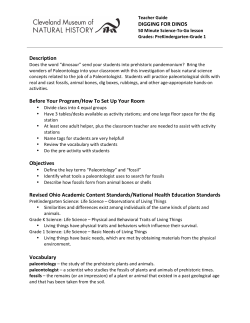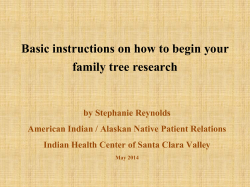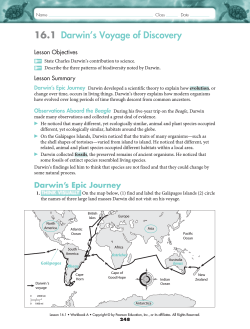
The Evidence for the Law of Evolution 1
The Evidence for the Law of Evolution 1 Pre-Darwinian Theories • Idea of evolution did not originate w/ Charles Darwin • Earliest references are from the Greeks; even Darwin’s grandfather believed in the common ancestry of all organisms • Jean Baptiste Lamarck (French zoologist) believed species were derived from preexisting species Inheritance of Acquired Characteristics • Widely accepted in early 1800s – believed organisms develop new organs or modify existing organs as environmental problems present themselves • Organs change as the need arises • Used giraffes as his explanation • Lamarck then suggested that those acquired traits were then passed on to the offspring (hence, offspring receiving acquired traits) • Another example would be a couple who enjoy bike riding, and become very proficient at it • What happens when they reproduce?... • Lamarck also believed the spontaneous generation of traits was an ongoing process that was PURPOSE driven • Eventually lead to “perfect” form • Although Lamarck’s mechanism of change was incorrect, he should be remembered for promoting idea of evolutionary change Darwin’s Theories • Summed up in 2 theories • 1. Descent with Modification: new forms appearing in the fossil record are actually the modified descendents of older species • Inferred that ALL species had descended from one or a few original types of life • Accounted for biogeography: similar organisms arise in the same geographic location • Modern kangaroos evolved from now-extinct ancestor 9 10 • Mitochondria arose from the Proteobacteria, a major group of Bacteria. • Origin of the modern life Eukaryotes and Organelles: Endosymbiosis • The eukaryotic nucleus and mitotic apparatus probably arose as a necessity for ensuring the orderly partitioning of DNA in large-genome organisms. • Mitochondria and chloroplasts, the principal energy-producing organelles of eukaryotes, arose from the symbiotic association of prokaryotes of the domain Bacteria within eukaryotic cells, a process called endosymbiosis (Figure 11.9). 13 The giant marsupial Diprotodon was related to the kangaroo, but grew to the size of a present day rhinoceros. The skull alone was over 1 m (3 ft) in length and was adapted for eating plants. The fossil remains of this giant marsupial are restricted in their distribution to Pleistocene deposits in Australia. 15 Biogeographical Record • Darwin noted on his voyage that – Islands are often missing plants and animals common on continents – Species present on islands often diverged from continental relatives – Island species usually are more closely related to species on nearby continents 16 Biogeographical Record • Darwin concluded: – Species arrive on islands by dispersing across the water – Dispersal from nearby areas is more likely than distant sources – Species that can fly, float or swim can inhabit islands – Colonizers often evolve into many species 17 Natural Selection • Fitness 18 19 • 2. Modification by Natural Selection – states how evolution occurs; environment limits the growth of populations by increasing the rate of death or decreasing the rate of reproduction, or both • May affect individual organisms in a population in different ways • Organisms w/ greater number of favorable traits will leave more offspring • Different degrees of successful reproduction is natural selection • If a trait both increases the reproductive success of an organism AND is inherited, then that trait will be passed on to many offspring • A population of organisms adapt to their environment as their proportion of genes for favorable traits increases • Resulting change is evolution (change over time) • A single org. genetic contribution to next generation is termed fitness • Organisms DO NOT purposefully acquire traits that they need (it would be nice though) • The environment ‘selects’ the traits that will increase • A favorable trait gives an organism an adaptive advantage • If environmental change occurs too rapidly, adaptations cannot occur fast enough Lamarck vs. Darwin • • • • • • • • Use and disuse Transmission of acquired traits Increasing complexity No extinction Variation Inheritance Differential survival extinction Evidence of Natural Selection • When the environment changes, natural selection often favors different traits in a species • Biston betularia: peppered moth – Light gray with black specks to jet black coloration – Black individuals have the dominant allele – Dominant allele was rare in the population until 1850s 24 Evidence of Natural Selection • J.W. Tutt hypothesized that light-colored moths declined because of predation • Light moths were easily seen by birds on darkened (sooty) trees 25 • http://www.techapps.net/interactives/pe ppermoths.htm 26 Evidence of Natural Selection • Bernard Kettlewell tested the hypothesis – Dark tree trunks = more dark-colored moths survived – Light tree trunks = more light-colored moths survived • When environmental conditions reverse, so does selection pressure 27 Evidence of Natural Selection • Industrial melanism: phenomenon in which darker individuals come to predominate over lighter ones • Pollution control resulted in lichen growing on trees and bark color being lighter again • Light-colored peppered moths now are dominant in the population 28 Evidence of Natural Selection • The agent of selection may be difficult to pin down • Could poisoning by pollution be the agent of natural selection? Selection against melanism 29 Evidence of Natural Selection Darwin collected a closely related group of 14 finch species in the Galápagos Islands – All were similar except for beak characteristics – Darwin hypothesized that different beak shapes were related to food gathering – Darwin wrote “…one might really fancy that…one species has been taken and modified for different ends.” 30 Evidence of Natural Selection Darwin’s finches 31 Evidence of Natural Selection • Modern research has verified Darwin’s selection hypothesis • 3 conditions of natural selection – Variation must exist in the population – This variation must lead to differences among individuals in reproductive success – Variation among individuals must be genetically transmitted to the next generation 32 Evidence of Natural Selection • Peter and Rosemary Grant studied medium ground finch • Found beak depth variation among members of the population • Average beak depth changed from one year to the next in a predictable fashion - Droughts: birds with deeper, more powerful beaks survived better - Normal rains: average beak depth decreased to its original size 33 Evidence of Natural Selection Evidence that natural selection alters beak shape 34 • Bacterial speciation may occur from a combination of repeated periodic selection for a favorable trait within an ecotype and lateral gene flow (Figure 11.26). A model for bacterial speciation • The model for speciation shown is based solely on the assumption of vertical (mother to daughter) gene flow. However, bacterial speciation is also affected to some degree by lateral (horizontal) gene transfer. Lateral flow is the transfer of genes between species by conjugation, transduction, and transformation. • http://www.pbs.org/wgbh/nova/beta/evol ution/arms-race-superbug.html 38 Artificial Selection Laboratory Experiments • Drosophila melanogaster (fruit fly) – Selected fruit flies with many bristles on abdomen – Chose only those with most bristles to reproduce – 86 generations later: average number of bristles had quadrupled 39 Artificial Selection Artificial selection in the laboratory 40 Artificial Selection Agriculture Corn looks very different from its ancestor 41 Artificial Selection Domestication of silver foxes are a result of artificial selection 42 Artificial Selection Can selection produce major evolutionary changes? Breeds of dogs: The differences among dog breeds are greater than the differences displayed among wild species of canids. 43 Fossil Evidence of Evolution • Fossils are the preserved remains of once-living organisms • Rock fossils are created when three events occur – organism buried in sediment – calcium in bone or other hard tissue mineralizes – surrounding sediment hardens to form rock 44 Fossil Evidence of Evolution • Absolute dating: age of fossils is estimated by rates of radioactive decay • Relative dating: position of the fossil in the sediment • Isotopes, like U238, transform at precisely known rates into nonradioactive forms. • The rate of decay is known as an isotope’s half-life 45 Fossil Evidence of Evolution Radioactive Decay 46 Fossil Evidence of Evolution Fossil records document the course of life through time 47 Fossil Evidence of Evolution • Fossils document evolutionary transition • The oldest known bird fossil is the Archaeopteryx • It is intermediate between bird and dinosaur • Possesses some ancestral traits and some traits of present day birds • Archaeopteryx was first found in 1859 48 Fossil Evidence of Evolution Fossil of Archaeopteryx 49 Fossil Evidence of Evolution Recent discoveries – Four-legged aquatic mammal • Important link in the evolution of whales and dolphins from land-dwelling, hoofed ancestors – Fossil snake with legs – Tiktaalik: a species that bridged the gap between fish and the first amphibian – Oysters: small curved shells to large flat shells 50 Fossil Evidence of Evolution Whale “missing links” 51 Fossil Evidence of Evolution Evolutionary change in body size and toe 52 reduction of horses • http://www.pbs.org/wgbh/evolution/librar y/11/2/quicktime/e_s_3.html 53 HOMOLOGOUS STRUCTURE • Similar features that originate in a shared ancestor (derive from same embryonic structure) • Can result from modifications that change an original feature to 2 extremely different types (wing and arm) Anatomical Evidence for Evolution • Homologous structures: structures with different appearances and functions that all derived from the same body part in a common ancestor • The bones in the forelimb of mammals are homologous structures • Different functions, same ancestor structure 55 Anatomical Evidence for Evolution Homology of the bones of the forelimb of 56 mammals 57 ANALAGOUS FEATURE • Serve identical functions and look similar • No anatomical/embryological similarity • Wing developed independently and differently in more-recent ancestors of each animal Analogous structures: wing of an insect, bird bat and pterosaur Anatomical Evidence for Evolution • Strongest anatomical evidence supporting evolution comes from comparisons of how organisms develop. • Early vertebrate embryos possess pharyngeal pouches that develop into: – In humans: glands and ducts – In fish: gill slits 59 Anatomical Evidence for Evolution • Vestigial structures: have no apparent function, but resemble structures their ancestors possessed Vestigial structures of a whale 60 Anatomical Evidence for Evolution • Humans – Muscles for wiggling ears • Boa constrictors – Hip bones and rudimentary hind legs • Manatees – Fingernails on their fins • Blind cave fish – Nonfunctional eyes 61 Anatomical Evidence for Evolution • Neck vertebrae – Geese: 25 – Plesiosaurs: 76 – Mammals: 7 • The giraffe has 7 vertebrae, very large in size, to make up for the length of the neck 62 ATAVISMS • An atavism is the reappearance of a lost character specific to a remote evolutionary ancestor and not observed in the parents or recent ancestors of the organism displaying the atavistic character. • Atavisms have several essential features: (1) presence in adult stages of life, (2) absence in parents or recent ancestors, and (3) extreme rarity in a population Anatomical Evidence for Evolution • Eyes – Mollusks: photoreceptors face forward – Vertebrate: photoreceptors face backward 64 Anatomical Evidence for Evolution Eyes of vertebrates 65 Anatomical Evidence for Evolution Eyes of Mollusks 66 • http://www.pbs.org/wgbh/evolution/librar y/01/1/quicktime/l_011_01.html 67 Anatomical Evidence for Evolution Developmental similarities reflect descent 68 from a common ancestor EMBRYOLOGY • During development, ALL vertebrates are similar, but fade as development proceeds Figure 2. Drawings of the developing human head and face between the 4th and 5th week (adapted from Nelson, 1953). The top row are side views, and the bottom row are face views of the same stages. The face develops from extensions and fusions of the pharyngeal arches, structures which are found in all other vertebrates, and which are modified in different ways in different species. Abbreviations: m, maxillary process (upper jaw); j, lower jaw; h, hyoid; n, nasal pit. • http://www.pbs.org/wgbh/evolution/librar y/04/2/quicktime/l_042_02.html 71 Convergent Evolution • Biogeography: the study of the geographic distribution of species – Some plants and animals have similar appearance but are only distantly related • Convergent evolution: the independent development of similar structures in organisms that are not directly related • Convergent evolution is usually seen in animals and plants that live in similar environments 72 Convergent Evolution • Marsupials and placentals – Marsupials: young are born in an immature condition and held in a pouch until they develop – Placentals: young are not born until they can safely survive in the external environment 73 Convergent Evolution 74 Convergent Evolution Convergence among fast-swimming predators 75
© Copyright 2025

















